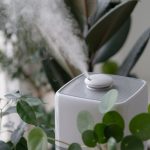Table of Contents
How do I know when it’s time to replace the filter in my humidifier?
There are a few clear signs that indicate when it is time to replace the filter in your humidifier. The most common reasons are reduced mist output, strange smells or odors emitting from the unit, increased noise when running, visible dirtiness or discoloration of the filter, or simply reaching the recommended lifespan guidelines provided by the manufacturer. Replacing the filter regularly helps ensure proper airflow and humidifier performance.
Humidifier filters work by absorbing minerals and impurities as moisture passes through them. Over time, the accumulation of these deposits causes clogging which reduces mist output. Additionally, the trapped mineral particles can promote bacterial growth and strange odors if not changed frequently. Keeping up with proper filter replacements helps maintain healthy and efficient humidity levels.
Best Anti-Microbial Humidifier
PureGuardian H5450BCA
view on Amazon


When is it Time to Change a Humidifier Filter?
Here are the top signs that indicate it’s time to replace your humidifier filter:
- Reduced mist output – If you notice the humidifier is not expelling as much mist as usual, the filter is likely clogged and needs changing. Restricted airflow through a dirty filter reduces moisture output.
- Strange smells or odors – If you smell anything odd like mildew, mold, or minerals coming from the humidifier, that’s a clear indicator the filter needs to be replaced. Trapped particles in the filter can promote bacterial growth and bad smells.
- Increased noise – Humidifiers tend to get louder as filters get dirtier. If yours starts buzzing, rattling, or making other strange noises, it likely needs a new filter. Clogged filters make the motor work harder.
- Visible dirt or discoloration – Routinely check on the condition of the filter. If it looks dirty, has debris on it, or is covered in dust and mineral deposits, it’s time for a replacement. A discolored filter means it’s clogged.
- Past recommended lifespan – Check your owner’s manual and follow the manufacturer’s advice on when to change the filter based on runtime hours or time period of use. If it’s been more than the recommended interval, replace it.
How Often Should You Replace Humidifier Filters?
The frequency of needing to change your humidifier filter depends on several factors:
- Filter type – The regularity of replacement needed varies by filter type. See average timeframes below:
- White dust filters: Every 1-2 months
- Wick filters: Every 1-2 months
- Washable filters: Rinse every 3-4 weeks, replace every 3-6 months
- Demineralization cartridges: Every 2-3 months
- Water hardness – If using hard water, more mineral deposits will collect requiring more frequent filter changes. Softer water extends the lifespan.
- Usage – Higher daily runtime hours also increases the rate of filter fouling. Humidifiers used more heavily need filter changes more often.
- Manufacturer guidelines – Consult the user manual and follow any replacement interval recommendations provided for your specific model.
To keep your humidifier working properly, check the filters regularly. Increased moisture output, reduced noise levels, and no foul odors are signs a fresh filter is doing its job. Keep spare filters on hand so it’s easy to promptly replace when needed.
DIY Humidifier Filter Replacement
Replacing a humidifier filter is typically a quick and simple DIY project. Follow these general steps:
- Unplug the humidifier first for safety.
- Remove the old used filter – check your instruction manual for the proper procedure as this varies by model.
- Inspect the empty humidifier interior and clean if needed to remove mineral deposits and debris.
- Insert the new replacement filter according to the manufacturer’s directions. Check that it fits correctly.
- Plug the humidifier back in and turn it on to test it out.
When buying a new replacement filter, be sure to select one specifically designed for your make and model humidifier. Double check the sizing and dimensions to ensure compatibility. Refer to your owner’s manual for guidance on model-specific filter replacement.
Why Replace Humidifier Filters Regularly?
Here are some key reasons why changing humidifier filters on schedule is so important for performance and safety:
- Maintains moisture output efficiency – Clogged filters reduce mist production. New ones optimize humidifying performance.
- Reduces microorganisms and mold – Changing filters prevents microbial growth in standing water and trapped particles.
- Prevents mineral scale buildup – Regular filter changes remove calcium and magnesium deposits.
- Eliminates odors – Old filters trap particles that cause bad humidifier smells.
- Allows proper air circulation – Unclogged, clean filters don’t restrict airflow and circulation.
- Ensures safe operation – Dirty filters make humidifiers work too hard, overheat, and increase fire risk.
- Prolongs humidifier lifespan – Routine maintenance prevents costly scale damage and repairs.
By replacing your humidifier’s filters as needed, you can keep your unit working properly for the cleanest, healthiest indoor air.
 Signs the Filter Needs Replacement
Signs the Filter Needs Replacement
Here is a quick summary of the signs that indicate it’s time to replace your humidifier filter:
| Issue | Cause |
|---|---|
| Reduced mist output | Clogged filter reduces airflow |
| Strange smells or odors | Trapped particles are breeding bacteria |
| Increased noise | Filter restriction makes motor work harder |
| Visible dirtiness | Mineral deposits, mold, and debris buildup |
| Past recommended timeframe | Filter lifespan exceeded according to manufacturer |
Conclusion
Replacing humidifier filters according to the manufacturer’s recommended schedule is crucial for proper performance and health. When output drops, strange smells arise, noise increases, visible dirt appears, or it’s been past the suggested timeframe, it’s definitely time for a new filter. This simple maintenance step allows your humidifier to run safely and efficiently.
Monitoring filter condition and staying on top of routine replacements provides the best results. Properly functioning filters remove minerals and particles, reduce microorganisms and odors, maintain airflow, decrease noise, and extend the operating life of your humidifier. Refer to the signs above to identify when your filter needs changed, and follow the manufacturer’s replacement guidelines for your model.









